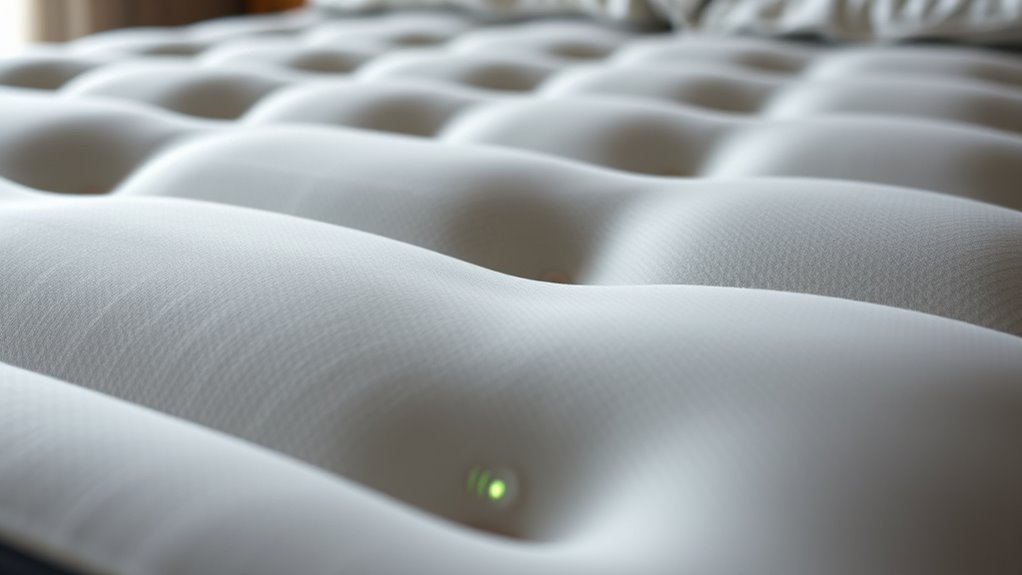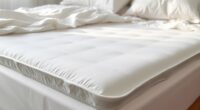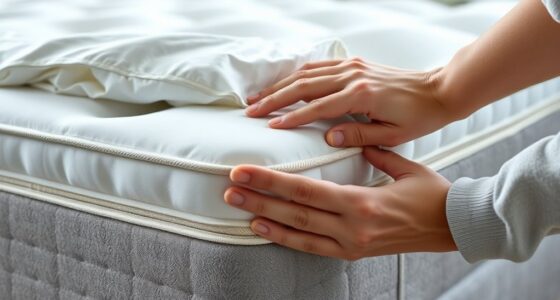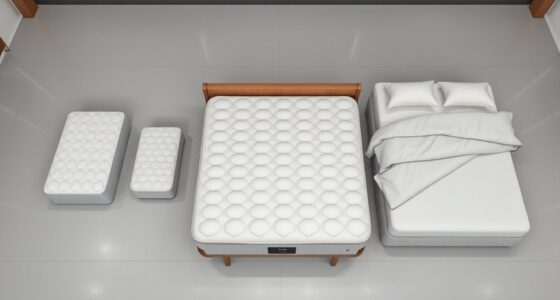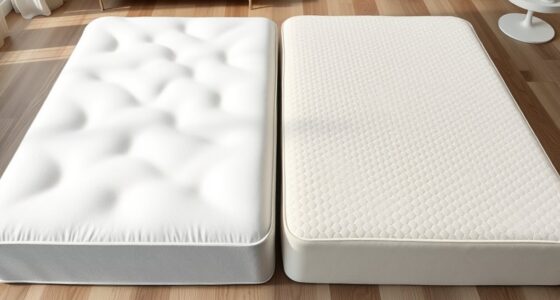To keep you comfortable during sleep, mattresses use breathable fabrics, cooling gels, and ventilation features that help regulate temperature. Breathable materials like cotton and bamboo promote airflow, preventing heat and moisture buildup. Cooling gels absorb and disperse excess heat away from your body, while open-cell structures and vents improve airflow through the mattress layers. Hybrid designs combine foam and springs for better breathability. Keep exploring to discover more ways your mattress keeps its cool all night long.
Key Takeaways
- Breathable fabrics like cotton and bamboo promote airflow, preventing heat buildup and moisture retention during sleep.
- Cooling gels infused in foam layers absorb excess body heat and disperse it for a cooler sleeping surface.
- Mattress designs with open-cell structures or perforations enhance ventilation and airflow around the body.
- Hybrid mattresses combine foam and innerspring coils to facilitate natural airflow and temperature regulation.
- Ventilation features and layered construction work together to dissipate heat, maintaining a comfortable sleep environment.

Have you ever woken up feeling too hot or too cold, struggling to find a comfortable sleep? If so, you’re not alone. Temperature regulation in mattresses plays a vital role in ensuring you stay comfortable throughout the night. Modern mattresses incorporate a variety of technologies and materials designed to manage heat and moisture, helping you avoid those restless, sweaty nights or chilly awakenings. One of the key components in achieving this balance is the use of breathable fabrics. These fabrics allow air to circulate freely, preventing heat buildup and moisture retention. Instead of trapping heat like traditional materials, breathable fabrics promote airflow, helping to dissipate body heat quickly and keep you cool. Materials such as cotton, bamboo, or specialized synthetic fibers are often woven into mattress covers or comfort layers to enhance ventilation.
Alongside breathable fabrics, cooling gels are another innovative feature found in many contemporary mattresses. These gels are infused into memory foam or other supportive layers to absorb excess heat and provide a cooling sensation. When your body heats up during sleep, the cooling gel reacts by absorbing that heat, dispersing it away from your skin. This process helps maintain a more consistent and comfortable temperature throughout the night. Cooling gels are especially effective because they work directly where your body contact is greatest, offering immediate relief from heat buildup. Combining these gels with breathable fabrics creates a synergy that markedly improves sleep quality for those who tend to overheat or experience night sweats. Additionally, the ventilation features incorporated into some mattresses further enhance airflow and temperature management, making them an ideal choice for hot sleepers.
The design of the mattress itself also influences temperature regulation. Many mattresses feature open-cell structures or perforations that facilitate airflow, enhancing the effects of breathable fabrics and cooling gels. Hybrid mattresses, which blend foam layers with innerspring coils, benefit from the natural ventilation provided by the coil system, while foam layers are engineered with cooling technologies to prevent heat retention. These layered approaches help create a cooler sleep environment, ensuring you don’t wake up feeling sticky or clammy.
Ultimately, understanding how temperature regulation works in mattresses allows you to choose the right one for your needs. Look for options that incorporate breathable fabrics and cooling gels, as they’re proven to promote better airflow and heat dissipation. Remember, a comfortable sleep isn’t just about support and firmness; it’s also about maintaining an ideal temperature. When your mattress actively manages heat, you’ll wake up feeling refreshed, energized, and ready to face the day.
Frequently Asked Questions
Are Temperature-Regulating Mattresses Suitable for All Sleep Positions?
You might wonder if temperature-regulating mattresses suit your sleep position. These mattresses are designed for flexibility, so they adapt well whether you sleep on your side, back, or stomach. Their breathable materials help maintain a comfortable temperature throughout the night, regardless of your sleep position. So, yes, they generally work well for all sleep positions, providing consistent temperature control and support for your preferred sleeping style.
How Long Do Temperature Regulation Features Typically Last?
You might wonder how long temperature regulation features last. Typically, these features have a lifecycle longevity of around 5 to 10 years, depending on usage and care. During this time, warranty coverage often protects against defects or malfunctions. To guarantee peak performance, follow manufacturer guidelines for maintenance. After the warranty expires, you may need replacement or repairs, but proper care can help extend the feature’s lifespan.
Can Temperature Regulation Be Adjusted Manually by Users?
Did you know that nearly 60% of mattress owners wish for better control over their sleep temperature? You can manually adjust your mattress’s temperature regulation with user control features, giving you personalized comfort. Many mattresses now include easy-to-use controls or apps, so you don’t have to rely solely on the mattress’s automatic features. This way, you can fine-tune your sleep environment for ideal comfort every night.
Do Temperature-Regulating Mattresses Require Special Maintenance?
You might wonder if temperature-regulating mattresses need special maintenance. Generally, they don’t require much more than regular bed maintenance and cleaning routines. To keep them functioning well, you should vacuum the mattress surface periodically and follow manufacturer cleaning instructions. Avoid using harsh chemicals, and guarantee proper airflow around the bed. With proper upkeep, your temperature-regulating mattress stays effective and comfortable without any complicated maintenance.
Are There Any Health Risks Associated With Temperature-Regulating Mattresses?
Think of temperature-regulating mattresses as a double-edged sword. While they help you sleep comfortably, you might wonder about health risks, like allergy concerns or skin irritation. Rest assured, most are made with hypoallergenic materials, minimizing health risks. However, always check for allergies to specific fabrics or materials. Regular cleaning and maintenance can further reduce any potential issues, ensuring your sleep remains safe and invigorating.
Conclusion
Think of your mattress as a trusted friend who always keeps you comfortable. Just like a friend who adjusts their support as your needs change, a temperature-regulating mattress adapts to keep you cool or warm. Imagine lying on a summer night, feeling the cool breeze thanks to smart materials working silently beneath you. With advanced technology, you can rest assured knowing your mattress will always keep your sleep just right—like a cozy, dependable companion.
